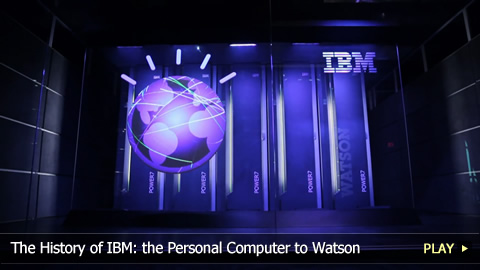The History of IBM: the Personal Computer to Watson

advertisement
VOICE OVER: Rebecca Brayton
Founded on June 16, 1911, the Computing Tabulating Recording Corporation is the company that predated International Business Machines Company, or IBM. From punch card technology all the way to the Watson supercomputer, this company has been changing the world one machine at a time. IBM's early word processing took the form of the Selectric line of typewriters, and the IBM Personal Computer was a triumph in the industry. Since the company first started, it has been a pioneer in the business world, both with its products and with its ground-breaking policies. In this video, http://www.WatchMojo.com learns more about the history of IBM.
The History of IBM
This is the largest computer company in the world, and it’s known as “Big Blue.” Learn more about the history of IBM.
Computing Tabulating Recording Corporation
Before changing its name to IBM, the Computing Tabulating Recording Corporation was incorporated on June 16th, 1911. CTR’s products were quite varied, but they all increased business efficiency. Just a few years after that company was officially formed, Thomas J. Watson, Sr. became president, and within four years he doubled the company’s profits.
Innovators in Workplace Policies
Watson’s appointment also resulted in a shift in policies at the company. In fact, IBM is credited with a number of changes that have indelibly influenced the American workforce. It was among the first companies to hire disabled workers, and it created an employee training program early on. IBM also instituted the 40-hour work week, and introduced group life insurance to its workers. It was also early in its acceptance of equal opportunity employment.
The Birth of IBM
Eventually, on February 14th, 1924, CTR’s name was officially changed to International Business Machines Corporation, or IBM. In the company’s early days, it achieved success for perfecting punched card technology, as well as a number of other innovations.
The Great Depression
IBM and Watson remained bullish throughout the Great Depression. In 1935, that gamble paid off when the company was awarded what was called the biggest accounting operation of all time by the U.S. government when it passed the Social Security Act. IBM was then put in charge of tracking employment records for 26 million American workers.
The 1940s
The company expanded significantly through the 1940s, and during that period made strides to enter the large-scale computing industry.
The 1950s and the IBM 701
IBM began the 1950s strong, and during the decade they began producing some of the world’s most popular business and scientific computers. For example, in 1952 the IBM 701 business computer was introduced to the public. By 1956, they had also revolutionized data storage by launching the world’s first magnetic hard disc. This machine was the size of two refrigerators, and cost roughly ten thousand dollars per megabyte.
Changing Hands
Amid these great strides, the company lost one of its founding fathers: Thomas J. Watson, Sr. passed away on June 19th, 1956. Control of the company was then passed to his son, Thomas J. Watson, Jr.
The Selectric Typewriter and the IBM System/360
Moving into the ‘60s, IBM introduced its award-winning Selectric line of typewriters, and this model went on to dominate the American typewriter market. Just three years later, in 1964 the Selectric typewriter became a pioneer in word processing by allowing typists to revise stored text. The company transformed the industry again that year by announcing the IBM System/360. This family of computers was the first modern mainframe computer system. By the end of the decade, IBM had also proved itself an important ally of NASA and the space program, and was instrumental in putting a man on the moon.
Changing the Face of Retail
IBM also began changing the face of retail. In 1969, they introduced the magnetic strips found on credit cards and within two years, this became the standard across the world. They further influenced retail by perfecting the technology that allowed stores to read UPC codes.
The Floppy Disc and the Personal Computer
IBM introduced a magnetic storage system called the floppy disc in 1971. Ten years later the company announced the IBM Personal Computer, and this caused another revolution in the business world. In fact, in 1982 Time magazine named the personal computer the “Person of the Year.”
Deep Blue
IBM went through some tough times through the late ‘80s and into the ‘90s due to changing trends in business computing. However, one positive event during this period was the invention of Deep Blue. This supercomputer defeated the world champion chess player, and foreshadowed another triumph for the company.
Watson Supercomputer
In 2011, another IBM supercomputer competed on the trivia-game show Jeopardy! against two human champions. The appropriately named Watson computer was able to process questions asked in natural language, and used its huge database of knowledge to win the game. Following this impressive showing, experiments placed Watson in a medical environment with the potential to answer doctors’ questions about medicines, diseases and diagnoses.
IBM continues to advance the computer industry, and will surely contribute a number of valuable discoveries over its next hundred years.


